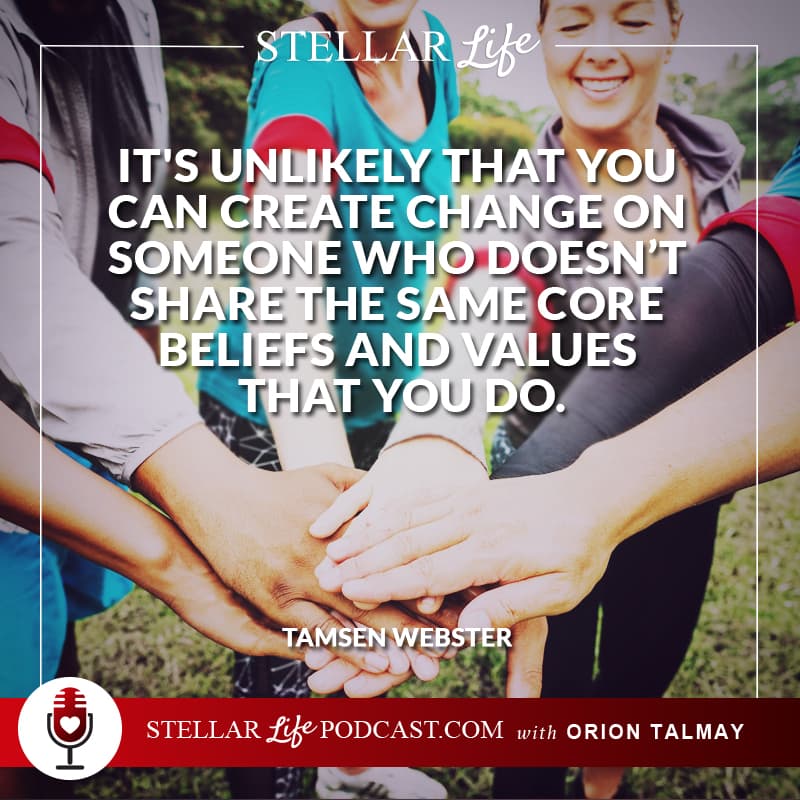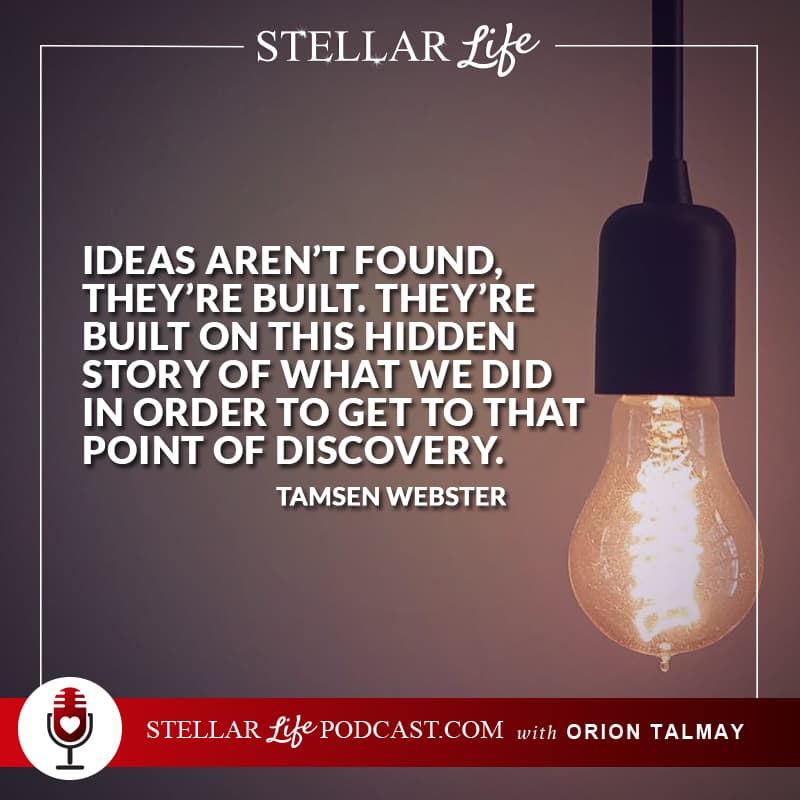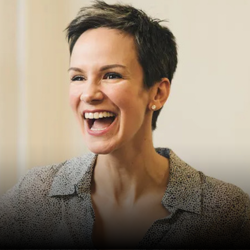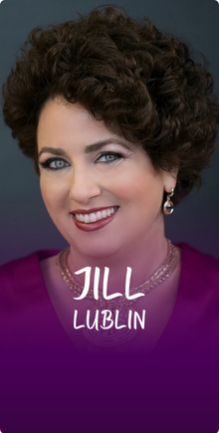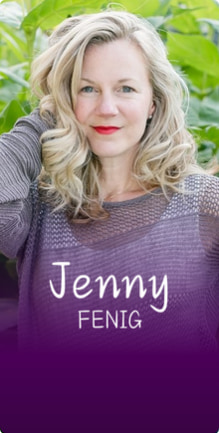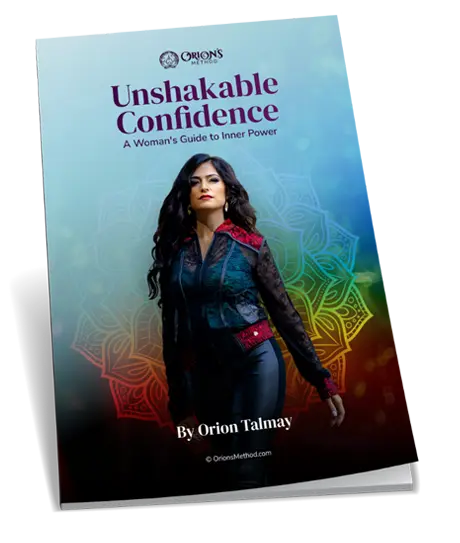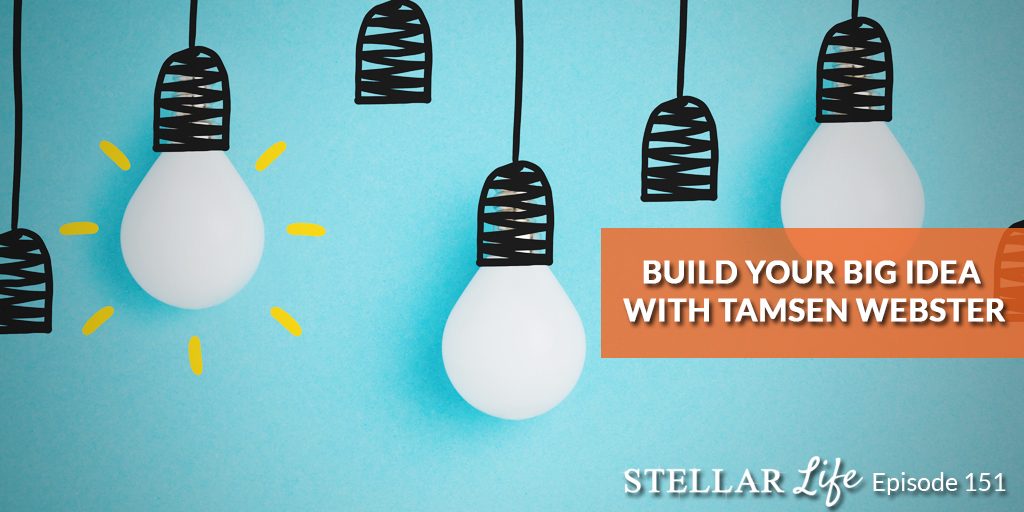
About Today’s Show
Hey, Tamsen. Welcome to the show.
Thanks, Orion. I’m excited to be here.
Thank you for being here. This is going to be exciting. Before we start, why don’t you share a little bit about yourself?
Well, let’s see. I think the thing that I love the most is someone once described me as the Idea Whisperer. That in many ways, once they said that I was like, “Ugh, yes.” I love that. I love that because it’s everything that I really hope to do. I love ideas, I’ve spent 20 years in marketing, messaging and brand strategy, finding ideas, finding the power in the ideas, trying to figure out how do we get ideas out there into the world, how do we get those ideas to have the impact that we want them to have. From marketing, to message development, to digital content strategy, to being a TEDx producer for four years, to now running my own business where I’m helping people in the organization to really find and tell the story of their ideas—that’s me. I think you can sum it all up in that “Idea Whisperer” name that a friend once called me.
That’s cool. Why are you so obsessed with ideas?
I think ideas, well, they hold possibility in them. They hold possibility in them because I think the reason why we come up with ideas, from what I’ve seen, is because we as humans are always trying to find new ways to solve old problems. We’re trying to find new answers to old questions. Ideas are amazing to me not only for the curiosity and the creativity that they demand but also because so often, the intent of an idea is to help, is to change, is to create a difference in a positive way somewhere in the universe and I just love that. I often say that I work best with people who are drawn to serve ideas bigger than themselves. It’s because that, to me, is what an idea is really all about—it’s about serving other people.
Yeah, I guess the reality of our world is it is what it is because of bad and good ideas.
Yeah, absolutely. I try not to spend a lot of my time on the evil ideas. Obviously, there are plenty of folks out there that have ideas where the question and the answer are very self-serving for them. Those are not my people. They’re not the companies I work with, they’re not the people I work with because it is very much a very particular kind of idea that I respond best to and then I work best with. As I said before, it’s the idea that there is a new way, a different way, your way to answer a question that other people have, or to meet an unmet need, or to solve a problem—that’s what I’m all about. Those are the ideas that I’m all about.
That is what an idea is really all about- it’s about serving other people. Share on XWhere do ideas come from?
I think a lot of times we think ideas come from a bolt out of the blue because we always think of Archimedes in the bathtub shrieking Eureka or Newton with the apple falling on his head and saying, “Oh hey, gravity.” But my experience and my research shows is that ideas aren’t found, they’re built. They’re built on this hidden story of what we did in order to get to that point. Really, that moment where you’re like, “Oh, I have a new idea,” is really the moment where the last piece falls into place and is the moment that the story that you’ve been telling without realizing it suddenly starts to pivot towards its conclusion. That’s an exciting moment. But to me, at a philosophical level that’s where they come from. Very specifically, they come from how you see the world and your desire to solve a problem in it.
I am a coach and I help women with awakening their feminine part and help them with confidence and self-love and attracting their soulmate. Being in the self-development world and studying with the greatest and going to a million seminars and workshops and all that, sometimes I hear a lot of the same ideas being recycled. It’s like you go to one seminar and you kind of hear it in a little bit of a different way. What’s the value in that? Sometimes I think about it, I’m like, “When I share my idea, how do I know if it’s “mine” or was it just an accumulation of all the freaking knowledge I was exposed to? It’s like, “Is that me? Is it somebody else? Do I get a download from the universal Google? Woah, what’s going on here?”
I love that. That’s amazing. Funnily enough, the answer is a yes to all of the above. I talk about this hidden story and then-famously people have talked about how there are only seven basic plots, or there’s nothing new under the sun, and to some extent that’s true. Where that comes from is that there are some persistent questions that exist in our life and our world and obviously, we haven’t fully solved them or else we wouldn’t be asking those questions anymore, and so I think that’s part of where some of that, let’s say, familiarity of idea just come from because we haven’t yet found an answer. At the same point, I don’t think there really is an answer because so much of where an idea comes from is contextual. Here’s what I mean, the thing that I see over and over again in my life, in my research, in my work—I’m sure you’ve seen this too—that how we see the world drives what we do in it. How see the world drives what we do in it. How we see is affected by two primary things: the things that we want and things that we believe to be true. The thing is, we feel like, “Okay, those things must not change,” but they do change. You might say in one situation that you always want to be surrounded by people and all that and then there’s going to be other situations where you actually don’t. That contextualism and that contextual nature of how we see what we want. What we believe really affects what ideas resonate with us at a certain time. I’m sure you’ve had this experience either yourself or perhaps, I’m going to guess with your clients, that you can say the same thing to someone multiple times over a period of time, and somehow, like at different times, they hear different parts of it; they’re ready for different parts of it. I think that’s key too.
It’s not that the knowledge changes, it’s that we changed and the way we pursue the knowledge changes.
Exactly. When it comes to whether or not your idea is really yours or whether it’s just the download from the universal Google, here’s how I look at it. When we talk about ideas being the product to how we see—how we see has got three big components. The see part is the perspective that we take in any given situation, that’s changeable. How we look at a situation is changeable. It can change in an instant and in fact, it is the change in an instant of how we see a situation that allows us to have that idea of what we can do differently in it. But the other two pieces are really important for us to look at as well and that’s the goal, that’s the things that we’re trying to get, those are those questions we’re trying to answer for ourselves, and the things that we accept or believe to be true in a particular situation. When it comes to generating your own ideas or packaging your ideas or sharing your ideas with other people and figuring out how it is that you can make sure they’re yours or to carve your own space out within it, each of those components is now an opportunity to do that.
Here’s what I mean, multiple people could be answering the same question. Let say, how can I be more fulfilled in my life and my work? I have a number of clients where that is, in essence, the question that they’re helping the clients or their audiences answer. But when you think about who’s asking the question, that’s one of the very first places where you can start to separate yourself from other people because you have said, for instance, Orion, that you work with women who are asking this question, other people might work with men or other people might work with people who are transgender or even with certain subsets we can look at how ready are these people to have that question answered. I’m sure you and your listeners have had that experience as well. It’s that sometimes we’re asking the question but we’re really far away from being terribly ready to actually do it.
People want to just listen to the answer. I think this is the satisfaction, “Oh, I got the answer. Now, I can go back to and do exactly what I used to do.”
Well, exactly. That gap, I live for that gap. That gap, that’s the monster I continue to try to slay and that is the gap between having a choice and making a choice. Many, many, many of us get lost in that gap because we can all look at situations where we know what the answer is. I often talk about weight loss because I’ve had a large one 19 years ago, 20 years ago in January over the anniversary of my maintaining a 50-pound weight loss…
My god. Wow. You look so beautiful.
Oh, thank you!

I would never imagine that you were ever overweight.
I was. The thing was at some level I knew what I was doing and so when I went into a doctor’s office and she said, “Don’t eat so much.” Totally not helpful because I didn’t think that that was my issue. It was and it wasn’t, kind of simultaneously. This is what I mean when we’re looking at, “Yes, what’s the goal of the people that you’re serving?” The people that you’re serving is one of those places to separate yourself from other people answering that same question. “How ready are those people? Who are those people? What values do those people have?” Because this is an important thing that a lot of people miss; entrepreneurs, marketers, brand or salespeople. We miss the fact that it is incredibly unlikely that you can create the conditions for change on someone who doesn’t share the same core beliefs and values that you do. I read a great article recently on some researchers were doing like what happens to your belief system. For instance, if you believe that everything in the universe is one, if you believe in this principle of oneness, how does that affect how you see people, how you see conflict and it has a massive positive effect on that. But if you’re somebody who’s working with clients and you believe in oneness, but they don’t, that fundamental split—everything you say because all your perspectives are shaped by that belief—it’s simply not going to resonate or even make sense to somebody who does not share that core belief.
Understanding who you’re talking to, what their goals are, what their beliefs are like I said, that’s the first place to really start to grab ownership of your version of an idea. Second place is how you frame the issue of why people struggle with that idea. One of the things that I see often when it feels like we hear the same ideas over and over again, I see this a lot in my clients, I see it when I read books or watch other people’s talks, is that a lot of times people only give, as I would describe it, one side of the problem. Not only that, they talk about a problem that we already know about, so back to my weight loss example, “Well, my doctor just said don’t eat so much.” I already knew that that was part of the problem, but it actually wasn’t the whole problem. The thing is if we can understand as the creator of an idea, somebody who’s trying to help other people if we can understand how most people are looking at it and how do we look at it with our perspective on it. For example, using the weight loss example, obviously, it’s not just the quantity of food because when my doctors said to me at that time, “Don’t eat so much.” I was like, “I don’t know what you’re talking about. They’re very small slices of cake. What do you mean?” It’s obviously not just the quantity of food. As anybody who’s ever figured this out and then tried to lose weight over the long-term, it’s also about the nature, the quality of that food as well. Both things have to be in place. This is what I mean by framing the problem.
There’s always really two parts because the perspective that I talked about, the thing that drives what you do, there’s the perspective that somebody currently has and then there’s the widening the perspective that they could have. For you, for instance, Orion, is you’re talking to people about how to achieve a particular goal, what’s getting in the way, you might be saying to someone, “Well, okay, we can look at thinking we don’t have enough time or that we’ve got this negative influences in our life or we don’t have enough money or maybe we’re doubting ourselves,” but ultimately—I’m not trying to put words in your mouth but I’m just using this as an example—but ultimately, you might say, “Really, the reason why those feel like such barriers to us is that we’re using them as external validators of what fulfillment looks like.” Whereas it’s useful to get those perspectives because of benchmarks, we have to also look at some kind of the internal drivers of your own fulfillment let’s say. You see what I mean by there are two parts there; there is kind of the conventional wisdom or the current wisdom and then there is the other view that you bring to it. Just simply that framing a lot of times is enough for you to really create ownership around a problem that many, many people may be talking about, a goal that many, many people have answers to. But simply the way that you say, “Hey, it’s not just this, it’s also this.” Or, “If you look at X, you’ll discover that Y always comes first.” Whatever it is, these two pieces are really critical because if you only give people one half, they don’t really understand why it’s different. That two-piece problem is super important.
I believe that we all are standing on the shoulders of giants and even people in my industry, for example, like Tony Robbins, when they are sharing their knowledge, it’s all based in other people’s knowledge. It’s almost like you’re curating ideas where you take other people’s ideas and then like you said, you shift it, you give it your own perspective and the way you teach it makes it yours. Of course, you have to give credit to some of the people…
Absolutely.
But still, the way you say it is the difference. Did I get it right?
Yeah. I love what you said about it’s not just kind of–it is about curating what else is out there but it’s also realizing why you’re adding to it. The thing is, a very few of us have one mentor or one book that we say, “That’s it. It’s done. Everything that I ever need to know is in that person or in that book.” The fact that you as an individual or any of your listeners as individuals aren’t satisfied with one, tells you that you have a perspective on the world and on that problem that’s different than what’s already out there. The key is to capture that difference. For me, what I found over and over again is it comes in naming that question of, “What question am I trying to answer? What’s the goal? How do I see the problem differently? What’s that problem of perspective that I see? How do most people see it? How do I see it? What are the truths that I have? What are the beliefs that I have that tell me that if I want this goal then it’s impossible not to take on this expanded perspective?” “Okay. If I’ve got all that then what does it mean that I believe we need to do differently?” We can either build it forward or diagnose backwards from when you’re out there representing a new idea or talking to your clients or audiences about whatever it is that your topic is for any of your listeners, it really is figuring out the core of why you weren’t satisfied with what other people were already saying about it?
Ideas aren’t found, they’re built. They’re built on this hidden story of what we did in order to get to that point of discovery. Share on XI like it. That sounds amazing. When you go to present your ideas on stages, and you do big keynote—you’re a big keynote speaker—how do you break down your ideas? How do you present it to people?
The structure I’ve been talking about frankly is the structure I use for everything. The reason why it’s the structure that I use for everything is because it is, in fact, the universal structure for how we as humans make sense of information. You’re probably familiar and I’m sure your listeners are familiar as well with the fact that as humans, we code information. The way people tend to describe it is we say that we code information in stories. I never quite understood that when people said that because I was like, “Well, I don’t code information with once upon a time there is a girl named Tamsen,” that’s not how I think about it. But then I had a very good friend of mine who’s a master storyteller. The way he thinks about a story I think is so useful because his definition of story is a story is a result of somebody pursuing what they want.
If you break that definition down further, he says, “There’s really three things that our brains are always looking for and science shows that this happens before we even consciously think about it, that we’re looking for three things.” Ron Ploof is my friend that I’m talking about. Ron says that these three things are roles. What are the roles of people and institutions? What roles are people playing? Influences, kind of whys. What are the motivations? What are the causes? What are the effects and events, what are the things that happen? If you think about it in that context, you realize that we’re always looking at any situation through that lens of who are the players, what is happening, why is it happening, what’s going to happen? What people want, why do they want it, what are they going to do as a result, or what happens as a result? The thing is if we understand that that’s how our brains work and if we can figure out, “Oh okay, well that’s how our brains work. How do we use that if we’re trying to get information across to other people?”
Then we realize, “Well, if we can have a useable structure for always making sure that those questions are answered for people, then we’ve got a really good way of getting information across. When I’m putting a new presentation together, if I’m working with corporate clients to do this or training people on this, the first question that I always have people ask is, “Who is it for? Who are you talking to? Who are they?” The next question is, “What do they want that you can help them get?” Remember, a story is the result of people pursuing what they want. That first question is to get that goal that I talked about before. That first piece, I’m always figuring out, I’m like, “What’s the goal?” When I’m turning into a presentation that’s the first pillar of my presentation is what I call the goal statement and the goal is the question that the audience is already asking that my idea can help them get. Then the second piece is that problem of perspective that I was talking about. The second thing I establish for my self as I’m planning out an idea or a talk is, I say to myself, “Okay, what do they think the problem is? Why do they think that’s a problem? What perspective are they taking? How do they see the situation right now?” And then I contrast that with how I see the situation.
For instance, a lot of times if I’m talking to people about ideas, I could talk about how can we share ideas that people act on them? That would be a goal statement. A problem statement would be, a lot of times, for all good reasons, we end up informing people about our ideas rather than implanting the ideas in their heads. It’s not that we can’t implant without informing but saying there are two pieces to this; there’s informing but there’s also this idea of how do we get it to stick? That’s the two pieces—goal, problem. The third piece ties in with those beliefs I was talking about before. Now, when I’m doing it with a talk or presentation or if I’m working with someone on a book, that third piece, that third pillar, kind of the third piece of the structure of the story of this idea is something I call the truth. The truth is something that is universally accepted to be true or is a provable fact, but it has to be something that the audience would readily agree that’s true and kind of on the surface of it, they’d have to readily agree that it’s true.
For instance, if was continuing my example about informing versus implanting, I would probably use the truth in that situation of how we code information using story structure. Or I could talk about how something like the ideas people like best are the ones that they think are their own. When we follow our own conclusions, as I heard another speaker say metaphorically, we rarely argue with our own conclusions. That’s one of those universal truths that I could use in the middle there to say, “Well, okay, we can inform people, we can implant, we also know that it’s true that people rarely argue with their own conclusions, going back to the goal, if you’re trying to really share your idea in a way that really makes people act then—and here’s the fourth piece—the change and thinking, your behavior, then what we need to do is make sure that we’re implanting the idea in a way that allows the audience to draw their own conclusions.
You see how it adds up so that you’ve got those four pieces; the goal which is the question, that two-part problem, that truth that makes that problem kind of impossible to ignore because if people draw their own conclusions, if you just inform people about stuff, they may not come to those conclusions, so, therefore, change. The change in thinking your behavior is, “Okay, we need to do this. We need to implant this idea in a way that gets them to draw their own conclusions.” The way I usually describe that same concept is if you really want to transfer an idea then what we have to do is create in the audience’s mind the same conditions that created the idea in yours in the first place. Then the last piece, if I’m presenting is, “Okay, what are the actions that make that change possible?” What are the specific steps that people could take or what criteria need to be present or what are the different areas of their life where they can apply this? Those are the pieces that I always figure out first. Together, I call those pieces The Red Thread of a presentation—the goal, the problem, the truth, the change, and the action. Once I’ve got that, I’ve got everything that I need to start to build it from there.

Can you say something in a way that informs versus help someone implement an idea?
Sure. That’s a thought-provoking question so let me see how I can do that on the spur of the moment. I can go back to the weight loss example. If you want to lose weight, you need to eat less and move more. Problem-solution. That’s really the difference between informing and transforming somebody with a message is whether or not you’ve given them a truth in between the problem and the solution. Going back to the weight loss example, the way that I lost weight—this is not necessarily an endorsement of Weight Watchers—was that I went to Weight Watchers. But the really important thing here is that Weight Watchers taught me a new truth and the new truth about food. Prior to Weight Watchers, I kind of saw all food and judged food by whether or not I liked it. Food was part of a balanced diet. As long as I just didn’t eat too much, too much cake, it was fine. But obviously, it wasn’t fine because I was overweight. And that actually comes back to the goal too because my goal wasn’t just to lose weight, my goal was quite literally to lose weight with cake. I mean, to be able to still eat in a way that I felt normal with that. My goal was, “How do I lose weight with cake?”
Without feeling deprived.
Without feeling deprived, exactly. As it turns out, I needed to change that perspective of how I was looking at food. Weight Watchers did that simply because they did what a lot of different programs do, they assigned an objective number to everything I put in my mouth. If you’re following keto or whatever, it can be net carbs, it can also be just straight calories, Weight Watchers has some, as you might know, a point value that’s a combination of calories, and protein, and sugars, and fat in food but either way, it’s the same thing. It’s for you to sign an objective number to food. Once you do that, all of a sudden, it instantly changes your perspective on food because if you understand that you have a number as well, if you’re keto, it’s a certain number of net carbs you’re trying to have in a day or a certain number of macros that you’re trying to have in a day. If it’s calories, how many calories you’re aiming for in a day.
For Weight Watchers, there’s a certain number of points in a day. Once you have that and once you know that and you have the points for the food, well, now you start to automatically do the math in your head. For instance, Weight Watchers is very friendly towards fruits and vegetables and so, basically all fruits and vegetables have no points, there are zero points. If I’ve got 28 points in a day, I’m naturally going to be inclined, if I’m hungry, to go for the things that have fruits and vegetables that have zero points because that allows me to have more space in my day for something like cake. Just by adding that true of all food has objective numerical value and so do you, it meant that I wasn’t just looking at the quantity of the food, I was also looking at the quality of it. Back to your question about how do I give the same message in a different way, I can say, “Well, if you’re looking to lose weight and still feel like you can eat what you want then we have to understand that the real problem isn’t just how much you eat but what you eat as well.” The truth is that all food can be judged by an objective point value, an objective number that helps balance out that quality-quantity equation which means if you want to lose weight and still feel like you’re not being deprived then choose the food that allows you to maintain that balance, and your health and happiness at the same time.
That makes sense because then like you said, you speak to the conversation they have in their mind and you solve the problem. Because the problem is they want to lose weight, the problem that is unspoken is, “I want to lose weight without feeling deprived.” You answer the problem that’s in their mind rather than the problem they talk about.
You answer both and that’s the power of it because you end up at the end of it saying, “And so really, it’s up to you.” And that “up to you” piece is actually quite critical when it comes to the difference between informing versus implanting or informing versus transforming is giving people agency. The thing is there is so much research that shows that if you tell somebody to do something, every fiber of their being fights back.
That sounds like me. Nobody can tell me what to do.
Exactly. But it’s totally normal. Anybody who has had children or just seen children knows this to be true that if you tell somebody to do something, there’s this automatic push back in the head that happens and it’s because generally, particularly in the Western society, we really value our freedom. The psychological term for it is Reactance. I saw a great article recently that called it the Braveheart Effect because it’s, “Follow me to freedom.” But I love that because that desire for freedom is critical. Remember that space we were talking about between having a choice and making a choice? If someone feels like they don’t actually have the freedom in that moment, they will make no choice at all or they’re going to make the opposite choice.
When my doctor said to me, “Don’t eat so much.” I wasn’t given any kind of choice in the matter, it was just, “Here’s the answer. Do it.” But when you say to people, “Well, hey, it’s up to you. If this is something that you want, if this is a goal that you want, if you agree that this expanded way to look at it is possible, and you agree with this truth, one of them is going to have to give, one of them is going to have give up there.” For me, I had to give up only looking at quantity. If I’m talking with audiences about this ideally, some part of their brain is going to say, “I have to give up trying to only inform people about what this idea is.” We have to give them that opportunity to choose because you can say, “Hey, it’s up to you. You choose here.” The trick is to put the pressure on to simply their perspective because it’s the least painful thing for somebody to change in a moment.
It's unlikely that you can create change on someone who doesn’t share the same core beliefs and values that you do. Share on XRight. That is so smart. The difference between talking at an audience or talking to an audience and really acknowledging the fact that they are smart human beings, probably some of them are smarter than whoever is on stage. Like, “I acknowledge your brilliance. I acknowledge that you’re a free person. I acknowledge your freedom of choice and it’s up to you.” It’s so powerful. For me, right now, I can’t even explain it, but it was like a lightbulb. It was like, “Ahh, I get it now in a different way.”
Well, that’s it. It’s because those pieces came into play. You can always go back and diagnose an aha moment for the same thing. It’s like, “Okay, what is it an answer to?” There’s like, “Oh, okay. Well, I’m trying to figure out how to connect really effectively with my audience.” “What have I been doing?” “Ahh, informing versus implanting.” “Ahh, what’s the new truth?” What’s the thing that I said that made you go, ‘Oh my gosh, that’s right.’ People can only choose what they’re given the freedom to choose.” Choose permanently, however you want to frame it, but it’s those pieces put together will suddenly make you go, “Oh, okay. I get it.” And it’s the “Oh,” that we remember. It’s kind of this hidden story behind it that we forget. But we need to reconstruct that hidden story if you’re trying to get somebody else to have the same idea or more specifically to come to the same conclusion about our idea. We have to walk them thru that step. We can’t just give them the answer because if you give them the answer it feels like, again, it’s back to this question of agency, it feels like you haven’t actually given them a choice.
It happens a lot in our school system.
It does.
Kids are just taught to like, “Just learn the fact, this is the truth, don’t think for yourself.”
It’s funny too because I’m a big fan of Gretchen Rubin’s latest book called The 4 Tendencies. In it, she talks about the four tendencies that we as people have and how we respond to expectation. She did a lot of work on habit and happiness. What she was finding as she went deeper into habit was that people’s ability to adapt a habit was very much related to how they responded to internal expectations, external expectations. Internal expectations–what do you expect of yourself. External expectations–what people expect of you. She divides that based on how you react, there are four different types. For instance, I’m a proud upholder, as she calls it which is somebody who meets in her expectations but also meets outer expectations. I’m pretty self-motivated but I’m always really conscious of what other people are expecting.
I will violate that if it makes sense to me–somebody else’s expectations. But I also won’t meet somebody else’s expectations to the detriment of myself. Now, the opposite of that is something called the rebel. It rejects all expectations—inner and outer. Those are the people oftentimes, as she explains, that very much oftentimes want to accomplish something but have to play fairly intricate games with themselves because they will get their reactance even if they tell themselves to do something. The reason I bring all these up is because I have one of my sons, who’s eight, is leaning strongly towards a rebel. I definitely have an upholder son, but I have another son who is I think probably what she calls it obliger which kind of meets other people’s expectations until they suddenly don’t. But what works for him is she calls it information consequences choice is the combination she calls it, so information consequences choice. Basically, what I will say is, “Okay, here is the situation, here is the choice. This choice leads to these consequences and this choice leads to these consequences.” The trick is as a parent you have to be willing to stand by the fact that you just gave them a choice and the consequences.
What happens over and over again when I remember to do that and I wish I would remember to do it more often, he’ll make a choice. He may not be happy about it, but he’ll at least make the choice which is different than saying, “Go brush your teeth.” Or, “Go do your homework.” Because now what I’ll say is, “Alright, here are your options…” because there’s one thing, he didn’t want to do his reading log for school. He’s supposed to read 30 minutes a night and he’s supposed to fill out the reading log. Well, he reads for pleasure for at least 30 minutes anyway, the log is the problem. What I said to him is like, “Listen, you can fill out the log. Your teacher knows that you’ve done it. You’re showing the teacher that you’ve done it. We’re happy to do it. I already know that you read, so if you didn’t want to fill out the log that’s fine. You don’t have to fill out the log. It means that you’re going to get docked for your homework grade,” but I said, “But I support it because you’ve done the reading.” And he’d be like, “I’ll do the log.” Because ultimately for him, it’s a cute little eight-year-old but it’s the truth about identity and for him, what’s worrying there is his own truth for himself about what’s valuable to him. To him, right now at least, not getting docked on his homework is more valuable than winning the battle of refusing to do it at all.
If I tell him to do it, that’s a battle guaranteed but if I give him the choice, it’s not. Generally, that’s true for most people. You just kind of have to figure out what are the choices that are going to be useful for them and that brings us all the way back to what we were talking about before which is how we see as contextual and how you present an idea to people is also contextual. But it’s why it’s so important that you think through even if you are presenting to 100, 500, 1000 people, that you’re very specific about who in that audience you’re talking to. I say this often to my clients and the people I train is the message is for one person. The talk or the book or whatever can be for everybody in the room. It is possible to structure it in a way that everybody gets something out of it but it needs to be for one person. If you get it for that one person, then the clarity will carry. It’s probably an overused metaphor but it’s the reason why in a loud room like a wedding reception or a cocktail party whatever, you can always hear somebody clanking on a glass because the sound is so clear. This is what we have to do with our own ideas is get them to the point of clarity where that one person hears it but because it’s so clear to that one person, everybody hears it too.

One of the common mistakes with communicating is not giving people a choice and we talked about that. What are other mistakes that we do when we communicate our ideas?
We assume people know as much about our ideas as we do. This is another classic psychological phenomenon called Curse of Knowledge which is once we’ve come to an answer about a thing or once we come to know a thing, it’s quite hard, if not impossible, for us to remember what it was like to not know that thing. You see this over and over again when it comes to communicating ideas because this is why we just want to give people the answer. Most of us, I like to think of it in terms of kind of slaying the monster, that your idea is your new way to slay a very old monster. It was probably hard work for you. You probably got injured on that journey and because you see other people fighting the same kind of monster, you want to save them. You just want to save them the effort and so you just try to hand them the tool, but they don’t know how to use it yet, they don’t know why it’s the right tool.
Unless somebody knows why it’s the right tool, it’s very possible they’re not just going to take hold of it. A thing that I see often is giving people, sometimes not even bothering with really outlining the story behind the solution, they just give people the solution. They say, “Well, just do this.” Sometimes, you can do that for a little while. I guess all my examples are weight loss today, but I see that for instance with people doing Whole 30 which has a very specific goal. But a lot of times people are following the Whole 30 plan which you basically eat only whole foods for 30 days. They’re doing it as a weight loss tactic and the thing is people will hear from other people, “Oh, do Whole 30. I lost a lot of weight. Here we go.” When it doesn’t work for them long-term or when they’re not able to sustain it long-term, they give it up. That’s because they were given a solution without really understanding what the problem was in the first place. With Whole 30, whether you agree with it or believe in it or not, Whole 30 is very clear of the fact that it wasn’t meant to be something that you did long-term, it’s not meant to be a diet, it’s not meant to be even a style of eating to maintain long-term.
It’s a way for, in 30 days, to identify the foods that are most inflammatory for you so that you can make adjustments to your diet afterward. If you don’t understand that going in though, you can come out just going, “This doesn’t work. I can’t do it. Why did I do it in the first place.” Another way to think about it is this, I heard someone recently, I love the way that they describe it saying, “You can’t learn to ride a bike by watching videos.” That’s true. My parents would always make fun of me because I was convinced that I could learn anything from a book—and still am by the way—but even if you understand, you can learn something in a book, but you have to do it before you really learn it. I taught myself how to knit from a book, but the book just tells you a thing, but you still have to sit there and do it before you go, “Oh I get it.” This is what I meant when I say that we suffer from this curse of knowledge when we’re talking to our audiences and the thing that we suffer from communication is that we think it’s enough to just give people the book or just show people the video of how to ride a bike or just give people the sword to slay the monster. We don’t.
We have to walk them thru some of the steps so that they really understand the whys and the where force of it, so that they can put it on themselves, so that they can walk thru the steps themselves, so that they can go thru the conditions and kind of retrace the steps to that idea themselves. It’s kind of what we said in the beginning, great ideas aren’t found, they’re built. What we have to do is rebuild that idea piece by piece in our audience’s mind. You can’t just open it up and put it in as it is. It’s too big. The idea is always too big for them to take it as one big dose. You have to give it to them in those little parts so that in their own heads, they rebuild it and it ends up becoming theirs and really, isn’t that the goal? Isn’t that the goal that they come to their own conclusion about it, it becomes their own idea, and they work with it the way they want to.
What’s your psychological process because I have that where I have the blessing of knowledge, I learned tons of modalities and sometimes I’ll come to maybe write my presentation or maybe convey an idea and it’s almost like I don’t want to feel like talking too much or repeating myself too much, but what sometimes can happen is that I speak in a very high-level where things make sense to me. I need to break it down more. I need to remember what it was like before I knew that idea. How do you make yourself remember that? What’s your internal process of breaking this down, of analyzing it?
It’s very much what we’ve talked about before and then I’ll add just kind of an additional layer of things that you can think about on top of it. The first thing is to say, “Okay, who are the people that I’m talking to? What do they want? What do they know they want–that’s really important. What’s the language they use?” Because a lot of times, nobody comes to me saying, “Hey, I’m looking for the true line of my idea. I’m trying to find the connection between how I see the world and what I do with it.” That’s not why people come to me.
No.
They’re coming to me because they’re like, “I need to write a new book.” Or, “I’m trying to pivot my career.” Or if it’s a corporation, “We need to make sure we get this idea out there in a really powerful way.” They’re asking communication questions typically and clarity questions. I’m asking them what do they want in their language, what is it they are saying, and really testing it about like, “Okay, say it to myself,” and this is where it can useful to really name the person that this is for, so I’m like, “This is for Chris.” How would Chris actually say this? What are they actually looking for? And then I say, “Okay, well, what did they think the problems are? Those are what I refer to the barriers, “Okay. Well, Chris thinks this is the problem and that’s the problem and this other thing’s the problem.” “Alright. But what is that symptomatic of? What’s the worldview that that’s a symptom of?” “Okay. That’s a symptom of thinking that I can just tell people the answer rather than show people the answer.” “Now, I’ve gotten my other half of it.” “Well, okay, what do I believe?” “Okay, great. What is the conclusion?” And then by starting with them and what they’re looking for, that’s one of the first and most critical ways. The second thing that I layer in is thinking through well, what are other objections and challenges to what I’m saying?” Like why would they object to that? What other question is going to be if I say that to them, what question is that going to raise in their mind? That constantly keeps me in the perspective of the person that I’m talking to. What question would they be asking right now? If I say this, what question will they ask? “Okay, great. What’s my answer to that?” “Alright. Once they answer, what’s the next question that they’re likely to ask?” “Great.” And then oftentimes that’s how I’ll use that to structure the presentation.
The intent of an idea is to help, to change, to create a difference in a positive way. Share on XThat’s really cool.
The third thing frankly is to make sure that particularly for those of us who are conceptual thinkers, I obviously am going to put myself in that category which can be a blessing and a curse is to remember that actually, the majority of people are not conceptual thinkers. The majority of people, about 73% of the population are what are called example learners whereas the conceptual people are rule learners. Rule learners can kind of see the underlying concept, the first principle is another word for it. You can see an example, an example, an example, and go, “Oh, I see what’s going on here. This is the rule.” The vast majority of people though go, “Oh that’s an example of this. Here’s another example. Here’s another example.” They need to see the examples to understand what you’re talking about. It means that when we get the idea, we have to make sure that we’re giving people example after example after example so that they really understand it. And then, and this is something that’s really cool, is that you can teach an example learner to start to see the rule if you show them the rule in the examples.
You have to give them the examples and say, “So, do you see this? Okay, here is the example. Do you see how these pieces here? Here’s the example. Do you see how this is connected? Here’s the example.” And then they can start to see it for themselves. I start back with who they are, what do they want, what do they value, what do they struggle with, I answer and kind of find those pieces of the red thread that I talked about and then while I’m building the talk itself, I’m constantly saying, “What questions will they ask? What do they need to understand before they’ll move with me to the next point?” And then the last thing I do is making sure that at the end of it all, I have given them enough information that they can see both the rules and the examples so they can put it into practice in their own life.
That’s amazing. Thank you for sharing all that. Before we finish, two questions. One, what are you three top tips to living a stellar life? Two, where can people find you?
Three top tips for living a stellar life; first, always carry snacks.
That’s the best one that I’ve heard.
I revolve around snacks. I love snacks. I have snacks all the time. Second, this is really important for me is to know what your domino is health-wise, physically is what I mean. What I mean for me personally is that it’s sleep. If I don’t get enough sleep, everything else falls apart. Second, only to snacks in my life is preserving sleep. That’s really important because if I don’t get enough sleep, I don’t even know how to describe it, other than the fact that everything else falls apart. I immediately see it. Yes, I can survive, and I’ve had to for days at a time when I only get five hours of sleep, but I know the difference between me and five hours and me on seven, eight or blissfully if I can get a nine. I really try to make sure that that’s in play. The third top tip that I would say for living a stellar life for me is to live without regret. I use a mantra to kind of keep myself in check on that because my husband was saying I’m a recovering perfectionist. The question I ask myself is, “Did I make the best decision I could given the information I had at the time?” Because a lot of times we’re judging ourselves, our former selves, or kind of a former version of us that made a decision based on new knowledge that we’ve gained since and that’s just not fair. The former, earlier you, didn’t have that information so we couldn’t see that. Those are my three tips.
Those are beautiful.
Thank you. Snacks, sleep, and no regrets. As far as finding me, I am somehow the only Tamsen Webster in the universe and you can find me at tamsenwebster.com.
That’s beautiful. Thank you, Tamsen. That was very eye-opening and very fun.
Thanks, Orion.
Thank you. Thank you, listeners. Now you have all the tools that you need, maybe not all of them, but a lot of what you need and the rest you can get from Tamsen about how to create your big idea and how to share it with the world because the world needs you and the world needs your ideas. Go out there and embrace everything that you are and share your ideas and live a stellar life.
